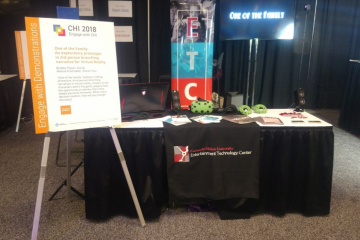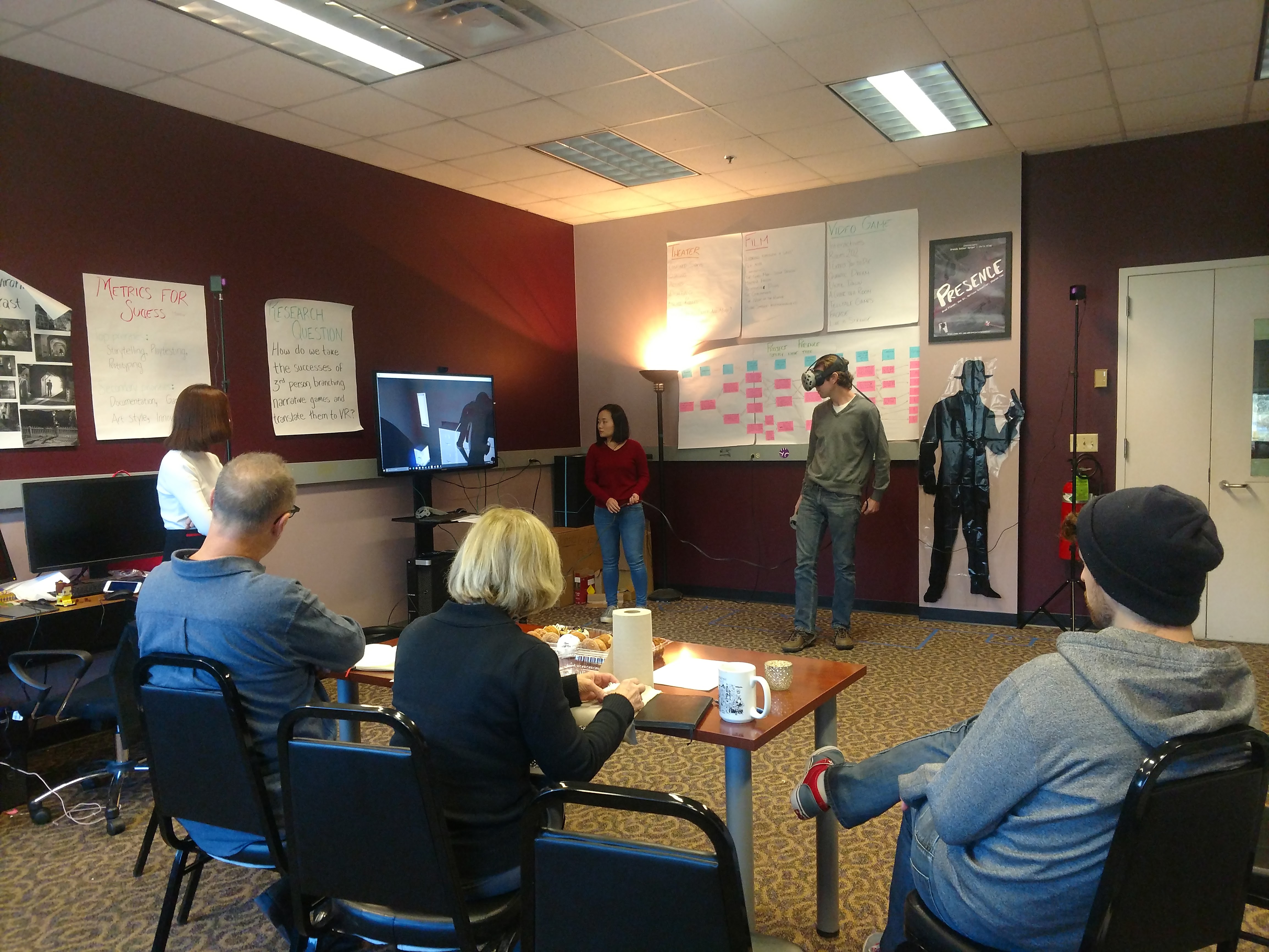Well, quarters went wonderfully!
We got everything we hoped for; everyone understood what our project was trying to accomplish, appreciated where we were in our development process, and seemed comfortable with our scope and schedule. This meant that they could really give us feedback on the things we needed. First, Jesse Schell, who specializes in game design, swung by our project room after walkarounds to talk about how we could implement interactions, and even gave suggestions on features we had not even considered. Then Jessica Hammer gave us tips on how to best administer our playtest. At the end of the week, Dave Culyba, Scott Stevens, and Ricardo Washington each sat down with us to discuss the project in depth and how we can best prepare for the coming weeks.
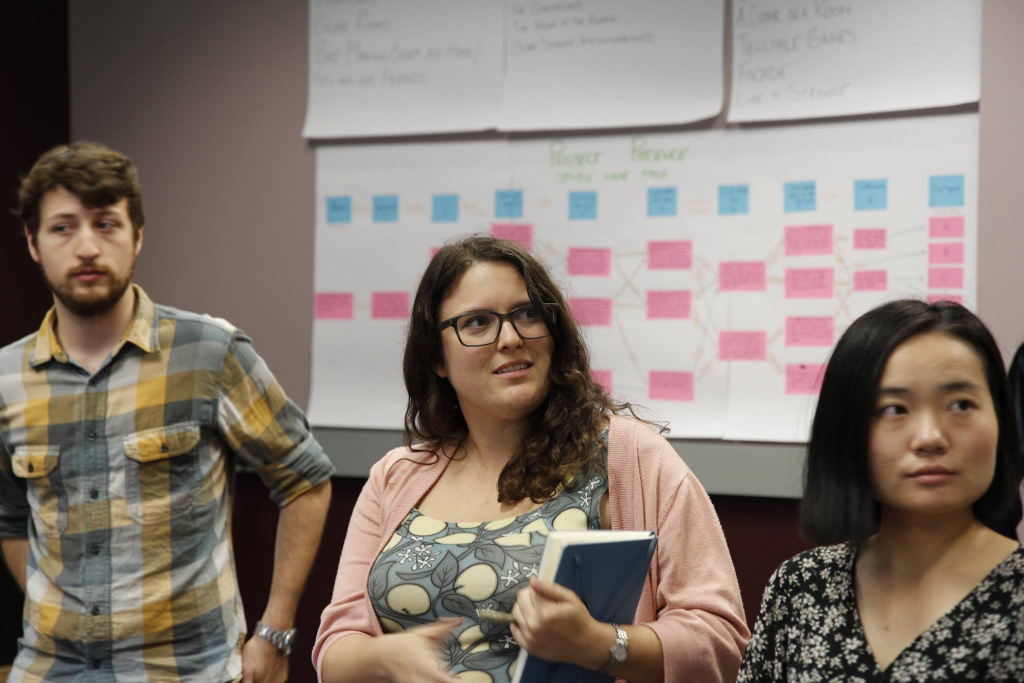
Brad, Melissa, and Zoe explaining the phases of playtesting
But that was not the most exciting part of the week. Brown box testing was!
Brown Box Testing
Now, what is brown box testing?
Brown box testing = a playtesting method used by VR game designers to test the game outside of the headset.
Testers will build out the entire environment using existing objects and creating what they don’t have out of cardboard or other easily buildable/strike-able material.
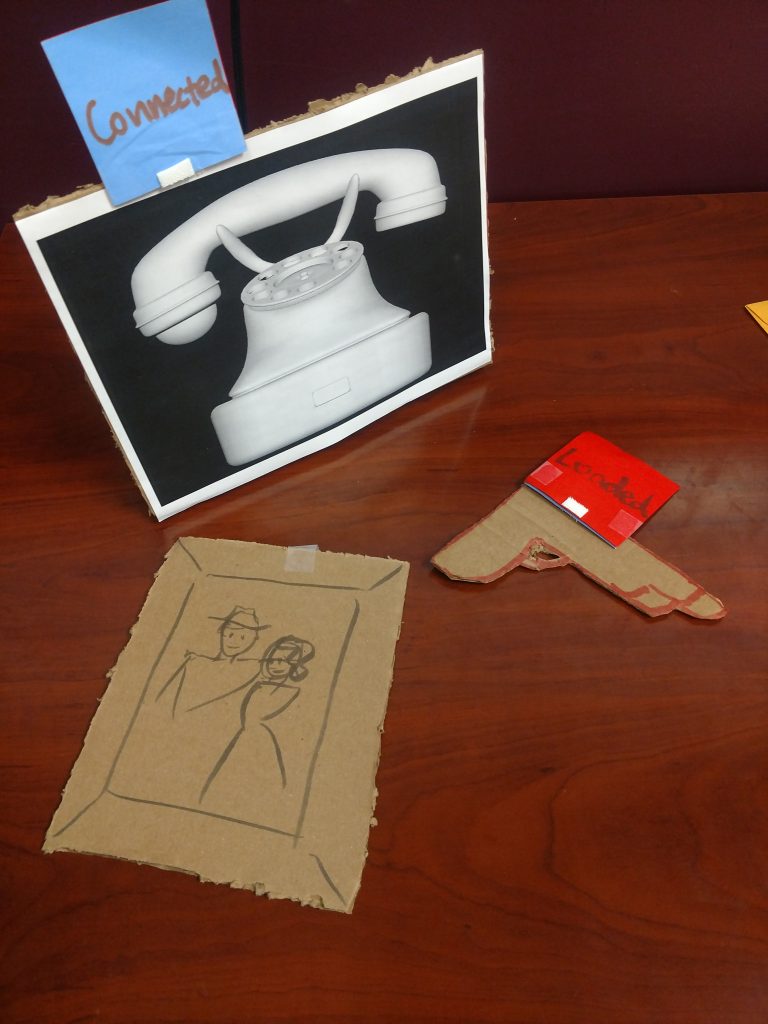
Our very realistic props with stick-note interactives
We were looking at a few different things in this playtest:
- How is successful are the pacing of story and choices since changes were implemented from previous tests?
- How is the story being comprehended now that there are multiple stimuli in the space?
- How successfully are we blocking the scene for three people (rather than just the two characters), so that the player always has a place to stand and feel comfortable?
After running it with 7 players, we came to some interesting conclusions.
1. Story and Choice Pacing
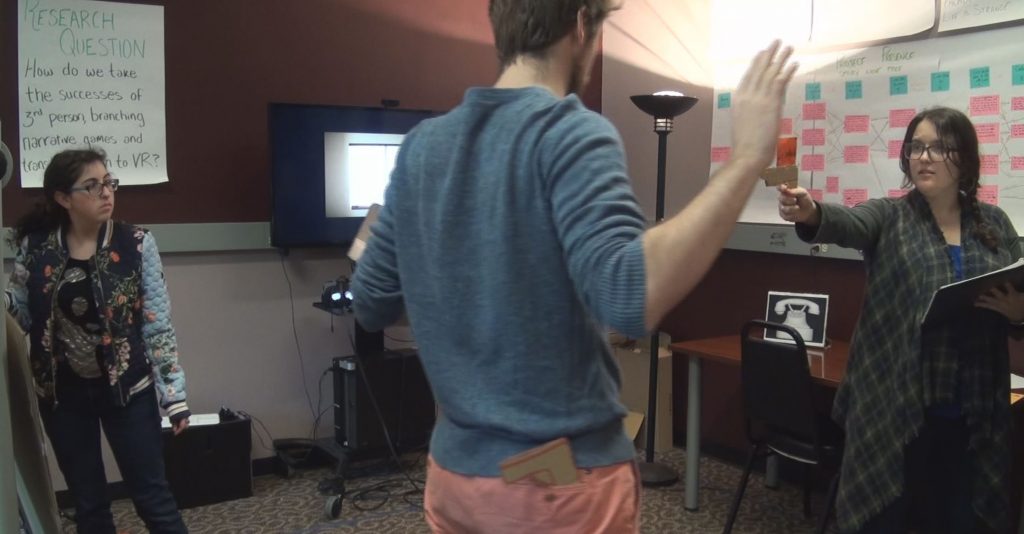
Brad and Melissa playing out the scene for a playtester
6 out of 7 players completely understood the story, however, they all had similar complaints. The opening sequence was so long and filled with so much exposition – with no interjecting opportunity for a choice to bring the player back into what’s going on – that players tuned out. Of the 6 that understood the story, it was because they picked up on enough of the exposition to get by. The one player who did not understand at all what was happening fell into that position because, in place of anything active to grab his attention, he chose to focus solely on the object interactions.
This long stretch of dialogue was the result of an over-correction from the table read playtest phase. During that run-though, testers felt they didn’t have enough time to acclimate to the game before they had to make a choice. This version with longer exposition was still better, but not great.
2. Adding Stimuli
Stimuli changed everything. As was touched on above, the presence of interactions meant that players felt torn between making changes to the environment and paying attention to the story. This forced us to acknowledge the reality that future playtests will have to investigate how much we want to signal to the player which choice is coming next.
When we asked players who struggled to pay attention whether they would have preferred to have only one object be interactive at a time, or to have a free-for-all where all objects can be altered (with no warning as to the order in which the objects will be locked), players indicated they would like something in between. They liked knowing from the beginning what their options would be, but having a sense of what was coming up would give them security enough to focus their attention.
3. Character vs. Player Positions
When it came to character placement throughout the scene, 6/7 times, it went smoothly.
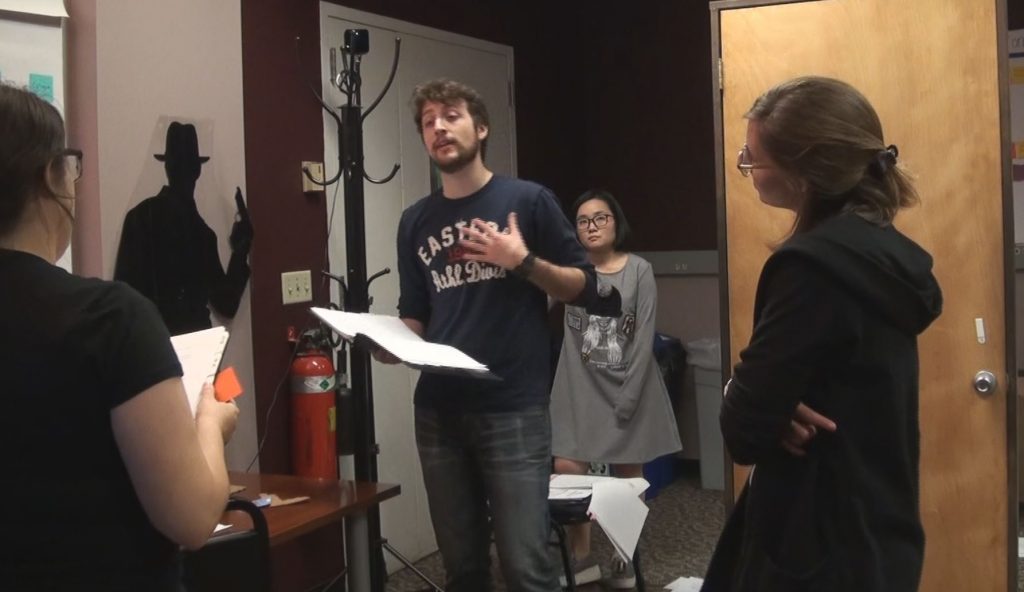
Our playtester standing exactly where we wanted her
Brad carefully plotted the scene as through it were a 3-person one. He anticipated where he wanted to player to be, and the player stood there. Above you can see Rony carefully considering the exchange going on between Melissa’s character and Brad’s. She felt comfortable watching and analyzing what she would want to do next.
But then came that 7th player….
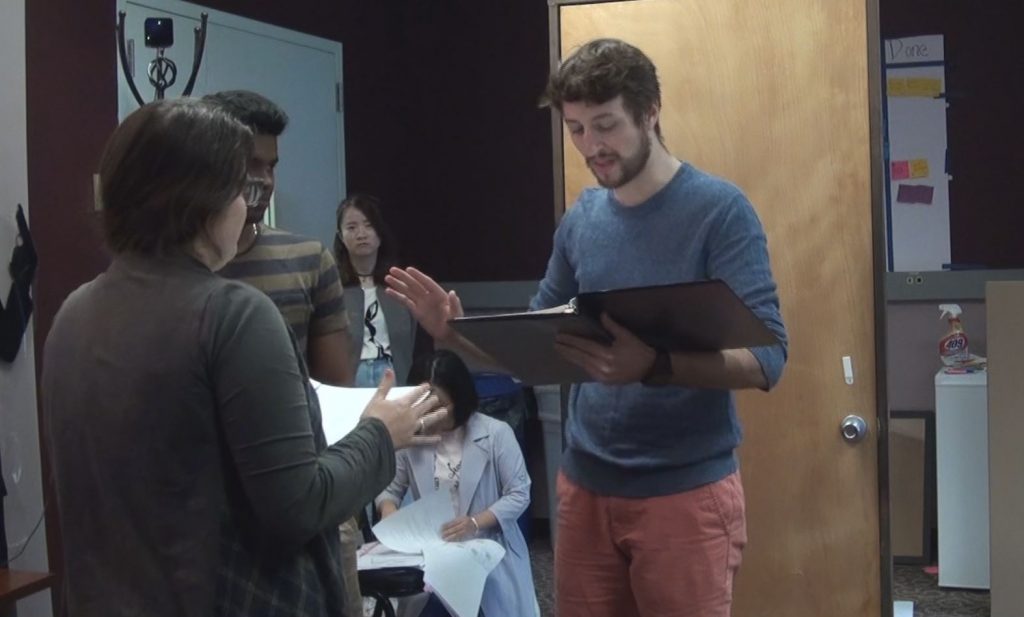
The playtester ending up exactly where we didn’t want him
Can you see him? Standing behind Melissa and next to the hat rack is a very invested yet entirely misguided player. Upon reviewing the scene, we realized that he watched the entire story in a different way than anyone else.
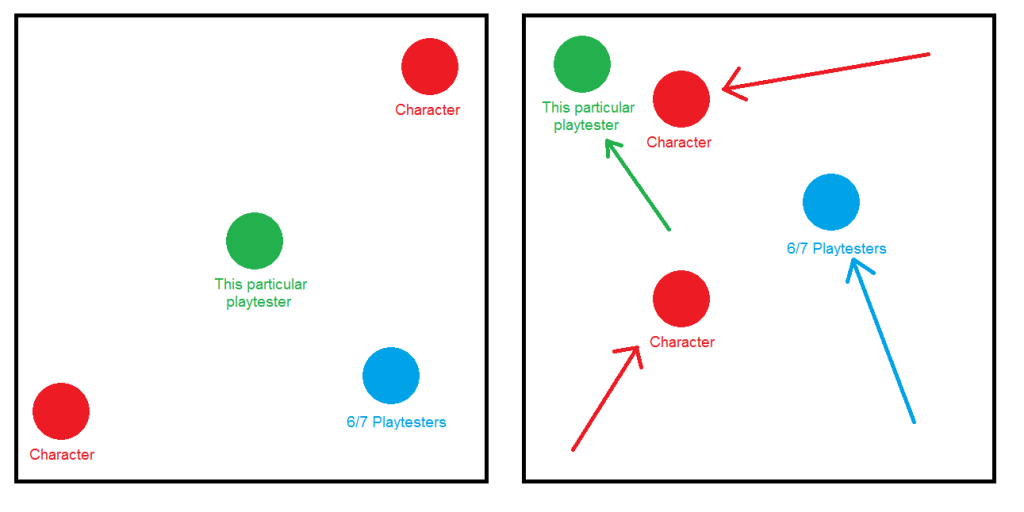
While other players had positioned themselves in such a way as to be able to view both characters at once, this player chose to put himself in the middle of the action. Generally we consider him an aberration: It is possible he isn’t well trained in framing for a narrative scene, or was unused to being a “non-character” (as he exclusively plays first-person shooters) and was continually trying to feel as though the characters were talking directly to him. All of this, however, is presumption; we have no conclusions as to why he moved the way he did, and given he was an outlier, we are choosing to acknowledge it for the moment as a fluke.
4. (Surprise!) Player Types
One thing we started to notice, but hadn’t necessarily been looking for was types of players.
Player types are patterns in player motivation that predict behavior.
The player types we observed were:
Intrigue
Players who were focused on getting the most interesting story.
“I connected the phone line because I wanted to see what would happen.”
Helper
Players who affiliate with the “protagonist” of the story and are choosing to take actions to help him.
“I really didn’t like Luca, and I wanted to make sure Giuli got out safely.”
De-escalator
Players who seek character harmony.
“I was never going to load that gun; someone could get hurt!”
Puzzle Solver
The player who is making choices based on a belief that there is a “right” and “wrong” answer pre-determined by the developers.
“I know I got the most interesting version of the story because I did what [the writers] told me to do.”
Griefer
The player who is deliberately trying to break the game.
The player stands in between the two playtesting actors and makes faces to try and get them to crack.
While these types are in no way conclusive, they very much informed our next draft because player types predict choices.
The intrigue, helper, and de-escalator player types are all great, but right now they all take similar routes through the story. Ideally they wouldn’t, since the intrigue player and the de-escalator player should theoretically be at odds (intrigue player loads the gun, de-escalator doesn’t). Brad is going to be doing another pass of the story to try and figure out how to ensure that these player types diverge early and often.
What’s next?
Story: Brad will be doing one more pass to make sure that everything we learned we need in terms of story is implemented, and then we lock in scenes. We can still make changes to individual lines to increase clarity, but in order to design characters, we need to know what actions they will be performing, and in order to be sure of that, scenes must be locked.
Character art: Once scenes are locked, we move forward with character art, taking the body measurements of our actors as a map for the skeleton, and testing various design options. You will hear more on that next week.
Environment art: With the environment almost entirely modeled, we can begin to install placeholder lighting and mess around with positioning to create the most comfortable space possible.
Motion capture: With mo-cap week right around the corner, our actors will be working on memorizing the characters they have been getting to know over the past couple of weeks. We will touch on their process during mo-cap week midway through October.
Playtesting: We will be moving on to live VR testing with the Vive trackers. After this week of pivoting, we will move on to developing the live testing build.
